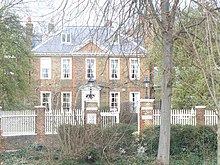Frances Douglas, Lady Douglas (26 July 1750 – 31 March 1817), formerly Lady Frances Scott, was the wife of Archibald Douglas, 1st Baron Douglas, and the mother of novelist Caroline Lucy Scott. Like her brother, Henry Scott, 3rd Duke of Buccleuch, she was closely acquainted with the novelist Walter Scott. She was an amateur artist, some of whose works have survived.
Early life

She was the daughter of Francis Scott, Earl of Dalkeith, and his wife the former Lady Caroline Campbell, who took the courtesy title of Countess of Dalkeith. Born three months after her father's death, she was reportedly shown little affection by her mother, who appeared "insensible to her merits", according to her own sister, Lady Mary Coke. A portrait of Lady Frances with her brothers was painted by Sir Joshua Reynolds in about 1758, and is thought to be the same work held by the National Gallery of Scotland.
In 1755, the Countess remarried, her second husband being the politician Charles Townshend, who took an interest in Frances as her step-father and supervised her education.
Literary society

In 1767, Frances travelled to Scotland for her brother's wedding; she remained at Dalkeith Palace for some time. She met Alexander Carlyle, minister at Inveresk, and they developed a friendship. He appreciated her wit and good taste. The corresponded, enjoying her skill as a belletrist. While she was away, Townshend died, and Douglas lost his guidance and protection. She thrived, though, in the literary society of the palace.
Her aunt Lady Jane Scott died in 1779 and left her a manor (now called Douglas House) in Petersham, London and a considerable financial inheritance. In 1782, Douglas and her brother traveled to Dublin and stayed with Lady Carlow. She was the sister of Lady Louisa Stuart, who was a close friend. While in Ireland, she met with Anne Townshend, her stepsister, who needed help sorting out the financial difficulties from an unfortunate marriage.
Marriage and children
On 13 May 1783, Frances married Archibald Douglas, at Grosvenor Square, London. Archibald, described as a 'safe ... and comfortable man', was married to her friend, Lady Lucy Graham, until her death in 1780. Part of the attraction for her marriage to Archibald was the affectionate relationship she had with his four children.
The couple had six children:
- Frances Elizabeth Douglas (died 1854), who married William Moray-Stirling, 17th of Abercairny, and had no children
- Mary Sidney Douglas, who married Robert Douglas and had no children
- Hon. Caroline Lucy Douglas (1784–1857), who married Admiral Sir George Scott, K.C.B., and had no children; she became known as a novelist
- Hon. Sholto Scott Douglas (1785–1821)
- Reverend James Douglas, 4th Baron Douglas (1787–1857), who married Wilhelmina Murray. He inherited the title of Baron Douglas following the death of his elder half-brothers, but had no children and the title then became extinct
- Hon. George Douglas (1788–1838)
Their family home was Bothwell Castle, where she entertained poets and authors in an atmosphere of 'ease, comfort and gaiety'. She entertained the French émigré aristocracy. Guest also included M. G. Lewis, Mary Berry, and Sir Walter Scott, who met Lady Louisa Stuart there in 1799.
Literature
Lady Louisa later suggested that Scott had based the character of Jeanie Deans in The Heart of Midlothian partly on Frances. Lady Louisa's memoir of Frances was written for the benefit of her family and was not published until 1985. The National Archives holds correspondence between Frances and her friend Dorothy Bentinck, Duchess of Portland, dating between 1766 and 1771.
References
- "Frances Scott (Lady Douglas)". Tate. Retrieved 29 January 2018.
- "Archive Services Online Catalogue Letter of commission by Archibald Lord Douglas". University of Dundee. Archived from the original on 29 November 2012. Retrieved 1 November 2011.
- Lady Mary Coke, The letters and journals of Lady Mary Coke, Volume 1, London, Kingsmead Bookshops, 1889
- "A Little Girl (possibly Lady Frances Scott, later Lady Douglas, 1750 - 1817)". National Galleries Scotland. Retrieved 29 January 2018.
- "Lady Frances Douglas". The Douglas Archives. Retrieved 29 January 2018.
- ^ "Douglas, Frances, Lady Douglas". Oxford Dictionary of National Biography (online ed.). Oxford University Press. doi:10.1093/ref:odnb/64082. (Subscription or UK public library membership required.)
- ^ M.C. Rintoul (5 March 2014). Dictionary of Real People and Places in Fiction. Taylor & Francis. p. 371. ISBN 978-1-136-11940-8.
- Lady Louisa Stuart, Memoire of Frances, Lady Douglas (Edinburgh, U.K.: Scottish Academic Press, 1985), page 97.
- John G. Lockhart (1837). Memoirs of the Life of Sir Walter Scott: In Three Volumes. Baudry's European Library. p. 313.
- DICKINSON, H.T. (1 May 1986). "Jill Rubinstein (ed.) Memoire of Frances, Lady Douglas". Scottish Economic & Social History. 6 (1). Edinburgh University Press: 85. doi:10.3366/sesh.1986.6.6.85. ISSN 0269-5030. Retrieved 29 January 2018.
- "Correspondence from Lady Frances Scott, daughter of Francis Earl of Dalkeith [d.1750], sister of the 3rd Duke of Buccleuch, and later the wife of Archibald Lord Douglas, to Dorothy Bentinck, Duchess of Portland". National Archives. Retrieved 29 January 2018.